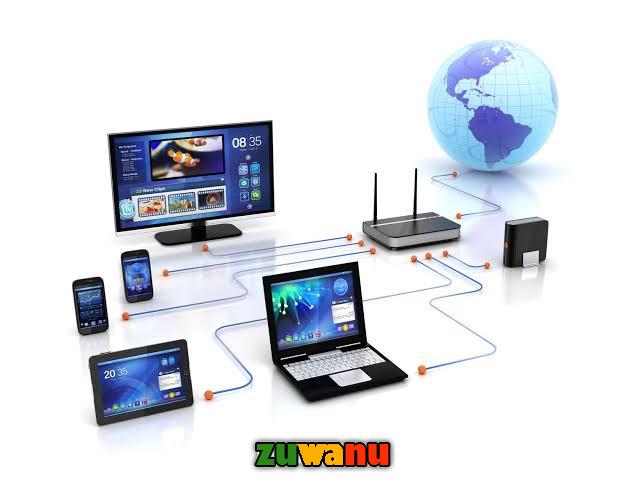Understanding Computer Networks: A Comprehensive Guide.

Understanding Computer Networks: A Comprehensive Guide
Introduction:
In the digital age, computer networks serve as the backbone of modern communication and information exchange. From the internet that connects the world to the local area networks (LANs) in our homes and offices, computer networks play a crucial role in enabling data transfer and communication. This article aims to provide a comprehensive understanding of computer networks, covering fundamental concepts, types, components, protocols, and their significance in today’s interconnected world.
Table of Contents:
What is a Computer Network?
Types of Computer Networks
2.1 Local Area Network (LAN)
2.2 Wide Area Network (WAN)
2.3 Metropolitan Area Network (MAN)
2.4 Wireless Networks
2.5 Personal Area Network (PAN)
2.6 Virtual Private Network (VPN)
Components of a Computer Network
3.1 Devices
3.2 Transmission Media
3.3 Network Topology
3.4 Network Services
Network Protocols
4.1 TCP/IP Protocol Suite
4.2 Ethernet Protocol
4.3 Wireless Protocols (Wi-Fi)
4.4 HTTP/HTTPS Protocol
4.5 DNS (Domain Name System)
Network Security
5.1 Firewalls and Intrusion Detection Systems
5.2 Encryption and Decryption
5.3 Authentication and Authorization
Network Management
6.1 Network Monitoring
6.2 Troubleshooting
6.3 Network Performance Optimization
Future Trends in Computer Networks
Conclusion
What is a Computer Network?
A computer network is a collection of interconnected devices that communicate and share resources, such as files, printers, and internet connectivity. These devices, known as nodes, are linked through physical or wireless connections, enabling data exchange and collaboration.
Types of Computer Networks:
2.1 Local Area Network (LAN):
A LAN is a network that covers a small geographic area, like a home, office, or school. It typically uses Ethernet cables or Wi-Fi to connect devices.
2.2 Wide Area Network (WAN):
WANs span larger geographical areas, often connecting LANs across cities or countries. The internet itself is the most extensive WAN, using routers and switches to route data across vast distances.
2.3 Metropolitan Area Network (MAN):
A MAN falls between LANs and WANs in terms of geographic coverage. It connects multiple LANs within a city or metropolitan area.
2.4 Wireless Networks:
Wireless networks, like Wi-Fi, eliminate the need for physical cables and provide flexible connectivity. They are prevalent in homes, public places, and businesses.
2.5 Personal Area Network (PAN):
PANs are the smallest networks, connecting devices within a short range, like Bluetooth devices.
2.6 Virtual Private Network (VPN):
VPNs create secure connections over public networks, ensuring data privacy and security for remote users.
- Components of a Computer Network:
3.1 Devices:
- Computers: The primary nodes in a network, responsible for data processing and communication.
- Servers: Centralized computers that store data, manage resources, and provide services to clients.
- Switches: Devices that forward data to specific devices within a network segment.
- Routers: Devices that connect different networks and determine the best path for data transmission.
- Hubs: Basic devices that connect multiple devices in a network but lack the intelligence of switches.
- Modems: Convert digital data from computers into analog signals for transmission over telephone lines (in older setups).
3.2 Transmission Media:
- Copper Cables: Used in Ethernet networks for data transmission.
- Fiber Optic Cables: Transmit data using light signals, offering high speed and reliability.
- Wireless: Radio waves and microwaves are used for wireless data transmission.
3.3 Network Topology:
- Star Topology: All devices are connected to a central hub or switch.
- Bus Topology: Devices are connected linearly, sharing a single communication line.
- Ring Topology: Devices form a closed loop, with data circulating in one direction.
- Mesh Topology: Devices are interconnected, providing redundancy and fault tolerance.
3.4 Network Services:
- File Sharing: Allowing users to access files from remote locations.
- Email Services: Facilitating email communication within a network.
- Web Services: Providing access to websites and web-based applications.
- Printing Services: Enabling users to print documents on networked printers.
- Network Protocols:
4.1 TCP/IP Protocol Suite:
- The foundation of the internet and most networks, comprising protocols like IP, TCP, UDP, and more.
4.2 Ethernet Protocol:
- Used in LANs for wired communication, defining rules for data framing and collision avoidance.
4.3 Wireless Protocols (Wi-Fi):
- IEEE 802.11 standards govern wireless communication, enabling devices to connect without cables.
4.4 HTTP/HTTPS Protocol:
- HyperText Transfer Protocol (HTTP) is used for web page retrieval, while HTTPS adds encryption for secure communication.
4.5 DNS (Domain Name System):
- Translates domain names into IP addresses, facilitating human-readable web addresses.
- Network Security:
5.1 Firewalls and Intrusion Detection Systems:
- Firewalls filter incoming and outgoing network traffic to prevent unauthorized access.
- Intrusion Detection Systems (IDS) monitor network activity for suspicious behavior.
5.2 Encryption and Decryption:
- Secure Sockets Layer (SSL) and Transport Layer Security (TLS) protocols ensure data encryption during transmission.
5.3 Authentication and Authorization:
- Username and password authentication, along with access control mechanisms, ensure only authorized users access the network.
- Network Management:
6.1 Network Monitoring:
- Monitoring tools track network performance, identify bottlenecks, and ensure optimal operation.
6.2 Troubleshooting:
- Diagnosing and resolving network issues to maintain uninterrupted connectivity.
6.3 Network Performance Optimization:
- Techniques like load balancing and Quality of Service (QoS) ensure efficient resource utilization.
- Future Trends in Computer Networks:
5G and beyond: Higher speed and lower latency for wireless communication.
Internet of Things (IoT): Connecting everyday devices to the internet.
Software-Defined Networking (SDN): Centralized network management for improved flexibility.
Conclusion:
In conclusion, computer networks have revolutionized the way we communicate, share information, and access resources. Understanding the components, types, and protocols of computer networks is essential for anyone in the digital age. As technology continues to evolve, staying updated with the latest trends and advancements will enable individuals and businesses to harness the full potential of computer networks.
Questions and Answers on Computer Networks:
Q1: What is the main purpose of a computer network?
A1: The main purpose of a computer network is to facilitate data communication and resource sharing among interconnected devices.
Q2: What is the difference between LAN and WAN?
A2: LAN (Local Area Network) covers a small geographic area, while WAN (Wide Area Network) spans larger regions and can connect multiple LANs.
Q3: How does a router differ from a switch?
A3: A router connects different networks and directs data between them, while a switch connects devices within the same network segment.
Q4: What is the significance of encryption in network security?
A4: Encryption ensures that data transmitted over the network is secure and cannot be easily intercepted or understood by unauthorized parties.
Q5: What role does DNS play in computer networks?
A5: DNS (Domain Name System) translates human-readable domain names into IP addresses, allowing users to access websites using familiar names.
Q6: What is the purpose of a firewall in a network?
A6: A firewall filters network traffic, allowing only authorized data to enter or leave a network, thereby enhancing security.
Q7: How does a VPN provide secure communication?
A7: A VPN (Virtual Private Network) encrypts data transmitted over a public network, ensuring that sensitive information remains confidential.
Q8: What is the significance of network monitoring?
A8: Network monitoring helps identify and resolve issues, optimize performance, and ensure smooth operation of the network.
Q9: How does a mesh network differ from a star topology?
A9: In a mesh network, devices are interconnected, providing redundancy, while a star topology connects devices to a central hub or switch.
Q10: What are some future trends in computer networks?
A10: Future trends include 5G technology, IoT integration, and Software-Defined Networking (SDN) for more efficient network management.
